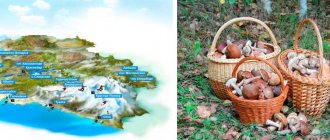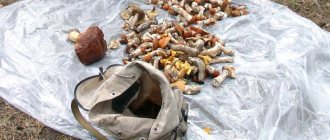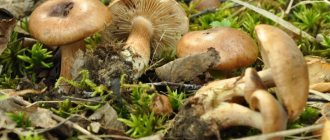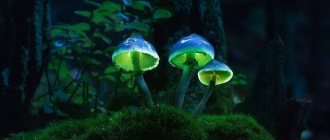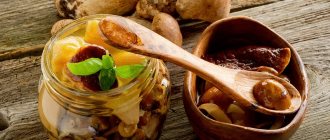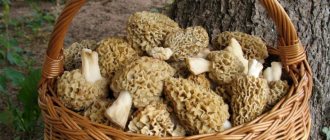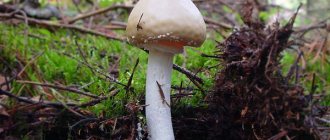The Perm region is an excellent place for picking mushrooms, since a significant part of the territory is covered with mixed and coniferous forests. Experienced mushroom pickers know the best places to collect this or that variety. For those who are traveling for the first time or are not aware of the peculiarities of the region, it is better to study information on the most successful locations. The beginning of autumn is an excellent time for collecting; the season lasts until the onset of persistent cold weather.
Mushrooms of the Perm region
This land is truly rich in mushrooms, because according to official sources, slightly less than a thousand species grow in the region. Owners of hats are found everywhere here: in forests, fields, small forests, along deep rivers. But only a third of this variety are edible. The rest are conditionally edible, inedible, poisonous. We'll figure out!
Flag of Perm Krai
Kirkazon clematis
A herbaceous plant belonging to the group of poisonous ones. It has heart-shaped leaves and reaches a height of 90 cm. A herbaceous liana with erect stems of a dark green hue, sometimes there are individuals with light green leaves. The leaf length reaches 10 cm. Yellow flower beds are located in the axils of the leaves. It blooms at the end of May, and pear-shaped hanging fruits appear a little later.
Edible
In the Perm region, approximately 300 species are edible. Porcini and boletus mushrooms are most common in the north of the region, where there are more coniferous and deciduous forests. There you can also find boletus , saffron milk caps , hedgehog mushrooms , chanterelles , russula , and fly mushrooms .
setasetatop
yui_in_lund
Closer to the center, mixed forests begin to offer even greater diversity. Here you can already collect not only all of the above species, but also boletus , aspen mushrooms , milk mushrooms , oyster mushrooms , and valui. In summer and autumn, mushroom experts collect honey mushrooms and milk mushrooms.
Michelbeeckman
whereyourbodysplit
gubanovaolga18
grazyna.de
Not everyone takes the risk of collecting such edible gifts of nature as cobwebs and sarcosoma. And in this amazing region, rare edible species, now listed in the Red Book, have been preserved: common veselka, olive-brown oak, mushroom cabbage, spurge.
_anacarlos
plantsnap
The shoe is real
Belongs to the orchid family, found in the Pacific regions, Eurasia, and in the Perm region - a rare plant. Forms stems up to 60 cm in height with long, wide and slightly wavy leaves, characterized by high density. During the flowering period, it forms large bracts, as well as an ovoid yellow center; the petals of the buds themselves are often brown.
Inedible
The first rule when picking is not to take a mushroom if you are not sure. Even though not all inedible specimens cause serious damage to health, they can definitely ruin any dish!
- False chanterelles. They can be immediately recognized by their bright, red cap, while the real one has a paler color. Another characteristic feature: the hat of a false chanterelle is smooth, even at the edges, while that of a real one is uneven and slightly torn. The false ones are not as tasty as the edible ones, but with a stretch you can still eat them after soaking them in water for 2-3 days. If you don't do this, you can get poisoned.
The fox is false. - pigs - a controversial representative of his species, which still causes a lot of controversy. Our ancestors more than once saved themselves from hunger by eating them, but now it has been proven that pigs are far from harmless. They accumulate toxins in their pulp, which, if consumed frequently, begin to cause severe damage to internal organs. If you still dare to cook pork, do not forget to pre-soak them for three days and also boil them thoroughly.
The pig is fat. - The shape of the gall mushroom is quite similar to the edible one: a thick stalk, a dense brown cap of the same color. Double mushroom. The taste is bitter; when cooked, the bitterness becomes even more pronounced. The fungus is not deadly, but its toxins can accumulate in the liver and destroy the body from the inside. However, due to the terrible taste it is almost impossible to eat. It differs from the porcini mushroom in that when cut, the flesh of the cap changes color to pinkish or brown.
Gall mushroom.
Adonis spring, or adonis
Adonis, as this flower is called, is distinguished by large yellow buds with sharp petals, arranged in 2 layers. It begins to grow in the spring, while the last snow still lies on the meadows. It has healing properties that are widely used in traditional medicine to treat inflammation and infection. Adonis buds are widely used for decorative purposes. The height of the stems is from 20 cm.
What is collected in spring, summer and autumn
The mushroom season in the Perm region traditionally begins in May and lasts until November, until the first noticeable frosts begin. There are mushrooms that delight us only for a certain time, and we need to have time to “catch” them. Some of them grow only in summer, others only in autumn. And there are those that you can collect almost the entire mushroom season. Let's take a closer look.
| Month. | Kinds. |
| May. | Morels, lines. |
| June. | Butter mushrooms, champignons, porcini mushrooms, boletus mushrooms, aspen mushrooms, champignons, russula mushrooms, chanterelle mushrooms, puffball mushrooms, tinder fungi. |
| July. | White, boletus, oak, russula, chanterelles, boletus, boletus, polypores, puffballs, champignons, umbrellas, hedgehogs, moss mushrooms, valui. |
| August. | Saffron milk mushrooms, milk mushrooms, oak mushrooms, boletus mushrooms, white mushrooms, boletus mushrooms, boletus mushrooms, aspen mushrooms, polypore mushrooms, puffball mushrooms, champignons, chanterelles, honey mushrooms, moss mushrooms. |
| September. | Russulas, garlic mushrooms, moss mushrooms, champignons, puffballs, oak mushrooms, valui, boletus, honey mushrooms, champignons. |
| October. | Russulas, garlic mushrooms, champignons, puffballs, milk mushrooms, saffron milk caps, boletus, oyster mushrooms. |
| November. | Autumn honey mushrooms, oyster mushrooms, raincoats. |
Blood red geranium
Perennial herbaceous plant with numerous carmine flowers. It has a specific smell; unlike indoor plants, it has pointed leaves. The height of the stems reaches 50 cm, they are covered with small hairs.
Several flowers grow on the stem in June or July, and fruit formation begins in mid-summer - September.
Tips for a mushroom picker
In October, you can collect an excellent harvest from a wide variety of mushrooms, but when going into the forest, you should take care of safety. If you are not an experienced mushroom picker, you need to know a few simple rules so as not to collect poisonous species. After all, October is their time too. For example, by accident you can pick up dung beetles, and if you consume these mushrooms with alcohol, you can get poisoned. There are also false honey mushrooms - this dangerous, poisonous species is very similar to ordinary honey mushrooms and only an experienced mushroom picker can distinguish them .
Never eat mushrooms raw, even if they are edible. Unprocessed mushrooms, even edible ones, can cause acute poisoning or stomach upset.- Follow the rules of orientation, take a compass and phone.
- Do not pick mushrooms that are spoiled or have thickenings on the stalk, hoping that you will cut off all the bad ones at home. Collect only good mushrooms. Therefore, when you cut a mushroom from the stem, break the cap to check if there are worms in it.
- Take a first aid kit with you, anything can happen in the forest, so a bandage and iodine should always be at hand.
- Collect only familiar mushrooms that you are confident in.
- It is advisable to collect the autumn harvest with an experienced mushroom picker. There are poisonous types of mushrooms that an amateur cannot distinguish from edible ones.
What edible mushrooms are collected in the Volgograd region
All these simple rules must be followed. This guarantees the safety of your health, and sometimes life.
Types of boletus in October
There are about 18 varieties of boletus in nature. They all bear fruit in the fall. Some of them are extremely rare and are found only in a limited area. A description of the most common specimens should be considered.
Spruce
The spruce boletus is found mainly in old spruce and mixed forests. His hat is chestnut brown.
In young specimens it has a hemispherical shape, and in old specimens it is straight. The surface of the cap is velvety, slightly wrinkled.
Note! At first, the plates of the mushroom are white, but then they acquire a yellow or greenish tint.
The stem is beige in color, thicker at the root. Its height ranges from 6 to 20 cm. The thickness of the leg ranges from 2 to 5 cm. The largest specimens reach 2 kg. The pulp is white, with an intense smell and taste.
The mushroom begins to bear fruit in early June and ends in October. The bodies appear both singly and in rings. Overripe large specimens are not harvested; they are left for animals. Animals eat them, spreading the spores.
Oak
This boletus often enters into symbiosis with old oak trees. Fruiting bodies often form near the roots of large trees. The hat is coffee-gray with minor light inclusions. Its diameter is 5-20 cm. With age, it becomes wrinkled.
With high humidity, mucus appears on the surface. The plates are white, but may turn yellow as they age. The flesh of a young mushroom will be dense but brittle. The height of the leg is 3-20 cm. Its color is milky or beige.
Appears in large groups from early June to October.
Birch
The birch boletus has a light yellow cap with a slight pinkish tint. Its diameter is 5-15 cm.
In humid weather, mucus appears on the surface. The pulp is white, but with prolonged contact with oxygen it can quickly darken and does not have an intense mushroom smell.
The plates of young specimens are milky in color, but may turn yellow over time. The leg is dense, barrel-shaped. It is distinguished by its light brown color. The tubular layer is yellow.
Note! This type of boletus forms mycorrhiza mainly with birch trees, so fruiting bodies can often be found under old trees.
Found both singly and in large groups. Begins to bear fruit in mid-summer. The peak is in September and October. When the harvest season begins depends on weather conditions.
Pine
The cap of this boletus species is dark brown in color with a slight reddish-violet tint. The edging is lighter. The diameter of the cap is 8-25 cm.
The pulp is highly dense and pale pink. It has a rich taste and aroma. The leg is thick, reaches 15 cm in height. Its surface is lighter in color than the cap. The thickness of the tubular layer is approximately 2 cm.
The first specimens appear in the spring. Fruits until the end of September. Rarely seen in October. The pine white mushroom has a lighter shade of the cap. This variety prefers sandy soils. It forms mycorrhizae with old pine trees.
Other
There are a number of varieties of boletus that are less common. These include:
- royal;
- reticulate;
- semi-white;
- dark bronze, etc.
Royal porcini mushrooms have a large pink or red cap. Its diameter is 8-22 cm. The thick barrel-shaped leg has a rich yellow tint, reaches 15 cm in height and 5-15 cm in diameter.
It is covered with a smooth peel. In older specimens, the surface is cracking. The pulp is milky in color, but upon contact with oxygen it acquires a blue-violet hue.
Important! King boletus loves limestone and sandy soils. More often it forms mycorrhiza with deciduous trees.
This variety has a rich taste and aroma. It is suitable for any heat treatment, drying and preservation. Can be consumed raw. Attempts are now being made to grow this variety under artificial conditions.
The net boletus has a light yellow cap. Its diameter reaches 30 cm. In young specimens it is smooth, and in old specimens it is covered with a network of small cracks. The pulp is dense, white and fleshy. The length of the leg reaches 3-12 cm.
It has a club-shaped shape, a beige surface with a pronounced retina. When broken, the mushroom emits a pleasant aroma. The fruiting bodies of this species are found in the steppe zone near rare trees or shrubs.
The semi-white boletus has a smooth, hemispherical cap. Its diameter reaches 15 cm. The pulp is dense, with a sweetish taste. The leg is thick, but its length rarely exceeds 15 cm. The tubular layer reaches 2.5 cm.
This mushroom is found mainly in deciduous and mixed forests, incl. in the Leningrad region.
The dark bronze boletus has a dense, convex cap, reaching 7-17 cm in diameter. It is covered with smooth, rich brown skin. The pulp is white, but darkens slightly when broken.
The leg is cylindrical, gray-pink in color with dark brown spots. This species grows in deciduous forests in warm regions. Peak fruiting occurs in mid-autumn.
The mushroom is rare, so attempts are being made to grow it under artificial conditions.
